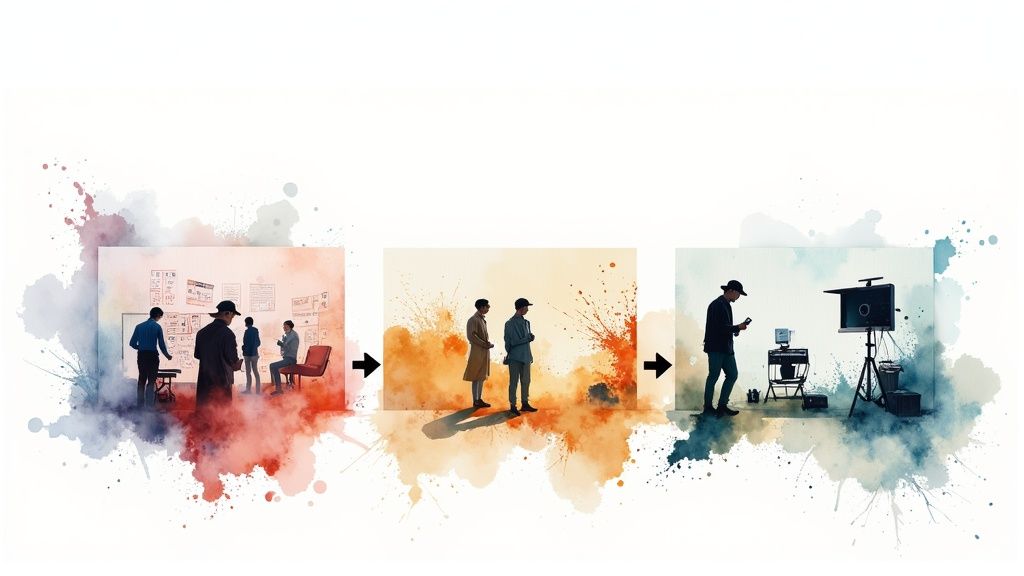In This Article
Subscribe to our newsletter
The Three Pillars of Modern Video Production
Creating compelling video content is more than just hitting record. It's a complex process, much like constructing a building. A building needs a solid foundation, framework, and finishing touches. Similarly, successful video production relies on three core pillars: pre-production, production, and post-production. These interconnected stages form an ecosystem guiding a project from concept to completion. Whether creating short marketing videos or ambitious films, this structured approach, favored by industry leaders, is crucial.
Pre-Production: Laying the Groundwork
Pre-production is the foundational phase, where the project's blueprint is meticulously designed. This stage encompasses everything from initial brainstorming and concept development to scriptwriting, storyboarding, and budgeting. It's here that the creative vision takes shape. Just as an architect drafts detailed plans, pre-production ensures everyone is on the same page, preventing costly revisions and delays. This includes securing locations, casting talent, and creating a detailed shooting schedule. Effective pre-production minimizes mid-project changes, allowing for efficient resource allocation. For more insights, check out this guide on video production project management.
Production: Bringing the Vision to Life
With the groundwork laid in pre-production, the project moves into the production phase – the actual filming. This is where the vision becomes reality. This stage requires a balance of technical expertise and creative flexibility. Directors and cinematographers collaborate to capture the desired footage, guiding actors, managing lighting and sound, and ensuring each shot aligns with the creative vision. Production demands careful coordination and problem-solving, as unexpected challenges can arise. However, a well-defined pre-production plan helps navigate these obstacles.
Post-Production: Polishing the Final Product
Post-production transforms raw footage into a polished final product. This involves editing, color grading, sound design, and adding visual effects. Think of it as the interior design of your video. This stage requires attention to detail and a deep understanding of storytelling. Editors carefully select the best takes, shaping the narrative and pacing for a captivating viewer experience. Sound design and color grading enhance the emotional impact, immersing the audience in the story. The rise of online streaming and platforms like YouTube has increased the importance of post-production. The global video production market, valued at USD 70.40 billion in 2022, is projected to grow at a CAGR of 33.5% from 2023 to 2030, driven by this increasing demand. You can learn more about the growing video production market. Ultimately, pre-production, production, and post-production are essential for creating high-quality video content. By understanding each phase and how they work together, creators can ensure well-planned, efficiently executed projects that deliver impactful results.
Pre-Production: Where Great Videos Are Really Made

The real magic of video production starts long before the cameras roll. It begins in pre-production, where initial ideas transform into a solid plan. This crucial first step is more than just planning; it's about building a blueprint for a successful production. Pre-production sets the stage for the entire project, addressing potential problems before they even appear.
Concept Development and Scripting
Concept development is the initial brainstorming phase. Here, you define the core message and target audience. The creative vision takes shape, establishing the video's style and tone. This involves crafting a compelling narrative that aligns with your project's objectives. Once the concept is finalized, the vision is translated into a script. A well-written script is essential for any successful video.
Storyboarding and Visualization
Storyboarding is like creating a comic book version of your video. It visually represents the script, using images to depict each shot. This process helps visualize the story's flow, camera angles, and transitions. Storyboarding allows for more precise production, minimizing on-set guesswork. For complex videos, this visual planning is crucial for communicating the director's vision effectively.
Budgeting and Scheduling
Budgeting and scheduling are two critical aspects of pre-production. Accurate budgeting ensures resources are used efficiently, keeping the project within financial limits. Realistic scheduling keeps production on track and prevents costly overruns. This involves estimating costs for equipment, crew, talent, locations, and post-production. A detailed schedule outlines the timeline for every stage of production.
Location Scouting, Casting, and Shot Lists
Location scouting is about finding the perfect setting for your story. This requires considering aesthetics, accessibility, and permits. Casting involves selecting the right talent to bring your characters to life. This goes beyond simply hiring actors; it's about finding individuals who truly fit the project. Finally, a shot list ensures all necessary footage is captured during production. This list details each shot, including camera angles, framing, and specific actions. A thorough shot list streamlines production and maximizes on-set efficiency.
To summarize the essential components of pre-production, let's take a look at the following table:
Pre-Production Checklist Components
This table outlines the essential elements that should be included in a comprehensive pre-production planning process, along with their purpose and typical timeline in the production schedule.
| Pre-Production Element | Purpose | Typical Timeline | Key Deliverables |
|---|---|---|---|
| Concept Development | Define core message, target audience, and overall style. | Early pre-production | Concept document, creative brief |
| Scripting | Create a detailed narrative and dialogue. | Early to mid pre-production | Finalized script |
| Storyboarding | Visually plan shots, angles, and transitions. | Mid pre-production | Storyboard, shot list |
| Budgeting | Estimate and allocate resources. | Early pre-production | Budget spreadsheet |
| Scheduling | Create a production timeline. | Early to mid pre-production | Production schedule |
| Location Scouting | Find suitable filming locations. | Mid pre-production | Location agreements |
| Casting | Select actors and talent. | Mid pre-production | Casting confirmations |
| Shot List | Detail all required shots. | Mid to late pre-production | Final shot list |
This table provides a clear overview of the key elements in pre-production and their importance in ensuring a smooth and successful video production process. Each element plays a crucial role, contributing to the overall quality and efficiency of the project.
Production: Capturing Moments That Actually Matter

With pre-production wrapped up, the video production process shifts into the production phase—the actual filming or recording. This is where meticulous planning transitions into dynamic action, and the vision carefully crafted in pre-production takes tangible form. Production demands a careful balance of technical precision and creative flexibility.
On-Set Dynamics: Balancing Precision and Spontaneity
Successful production relies heavily on the collaborative spirit between the crew and the talent. Experienced directors and cinematographers understand the importance of a collaborative environment. This involves clear communication, efficient workflows, and a shared understanding of the project’s objectives. Such an environment allows for both technical precision in capturing planned shots and the adaptability to capitalize on unexpected creative opportunities.
Creating an Environment for Authentic Performances
Even with the pressures of tight deadlines and technical complexities, creating a space where talent can deliver authentic performances is paramount. This often means building a rapport with actors, offering clear direction, and allowing room for improvisation within the structured framework of the script. This could be as simple as ensuring a comfortable on-set atmosphere or as complex as integrating actor feedback into the creative process.
Maintaining Quality Control During Production
The production phase can be quite demanding, with numerous moving pieces and the potential for unforeseen challenges. Maintaining quality control in this dynamic environment requires constant attention. This means regularly reviewing footage for technical glitches, ensuring consistent lighting and sound, and addressing any deviations from the planned shots. Effective communication between the director, cinematographer, and other key crew members is essential for making necessary adjustments on the fly without disrupting the overall production flow.
Capturing Essential Footage While Remaining Adaptable
While sticking to the shot list developed in pre-production is important, seasoned production teams know the value of being adaptable. Unexpected moments, improvised dialogue, or unique lighting conditions can often lead to the most captivating footage. This means being prepared to capture all the necessary elements for editing while remaining open to spontaneous creative sparks. This delicate balance ensures the project remains true to its original vision while embracing those unscripted gems that can elevate a video from good to truly exceptional. The growing use of video across industries further emphasizes the importance of this stage. Currently, 91% of businesses use video marketing, a number projected to increase as 42.6% of the global population is expected to watch videos on mobile phones by 2025. These statistics highlight the rising importance of high-quality video production in effectively connecting with audiences. Find more detailed statistics here. The production phase is where the heart of the video is captured, establishing a solid base for a compelling final product.
Post-Production: Transforming Footage Into Captivating Stories

Post-production is where raw video footage transforms into a polished story. It's more than just assembling clips; it's where the narrative finds its voice. Skilled editors weave together visuals, sound, and graphics, creating a captivating experience for the viewer. This process requires a deep understanding of pacing, structure, and how to keep the audience engaged.
Organizing Footage: The Foundation of Efficient Editing
Before the creative editing begins, organization is paramount. This crucial step ensures a smooth and efficient workflow. Think of it like preparing all the ingredients before cooking a complex meal. Professional editors use robust file management systems to handle large amounts of footage. This involves carefully labeling clips, creating detailed logs, and using software like Adobe Premiere Pro to categorize and quickly find footage. This meticulous approach saves time and reduces frustration during the editing process.
The Art of Editing: Shaping the Narrative
Editing is about making deliberate choices to enhance the story. It involves understanding how viewers engage with content. Editors use pacing to create tension and anticipation. They manipulate the structure to guide the viewer through a compelling narrative arc. Visual continuity, ensuring smooth transitions between shots, is also vital for a seamless experience. For example, misused jump cuts can disorient the viewer and disrupt the flow. This is where the editor's artistic judgment shines, shaping the video's impact through subtle yet powerful decisions. You might find this helpful: How to create video ads that convert.
Enhancing the Story: Sound, Color, and Graphics
Sound design, color grading, and motion graphics are essential for enriching the viewer's experience. Sound design adds depth and emotional impact. A well-placed sound effect can amplify tension, while the right music sets the mood. Color grading shapes the video's emotional tone. Adjusting colors can create feelings of warmth, coolness, or drama. Finally, motion graphics can enhance key messages without being distracting. This might involve using text overlays for emphasis or subtle animations to highlight visuals.
Managing Revisions and Optimizing for Delivery
Post-production also involves managing feedback and preparing the final video for distribution. This requires balancing creative vision with client expectations. Clear communication and a structured revision process are crucial for incorporating feedback effectively. Technical aspects are also important, ensuring the video looks its best on different platforms. This means optimizing resolution, file format, and aspect ratio for various devices. The growing importance of video is undeniable. In 2023, over three billion internet users watched streaming or downloaded videos monthly. This led to a 23% increase in global internet traffic. More statistics can be found here. Post-production is the final step in transforming raw footage into a polished, captivating product.
Building Your Dream Video Production Team
Creating a successful video isn't a one-person job. It requires a coordinated team effort. Behind every great video is a production team, a group of skilled individuals working together. Let's explore the roles within a video production team, how these roles have changed, and how to build the perfect team for your project.
Key Roles and Responsibilities
Traditional roles like director, cinematographer, and editor are still essential. However, the boundaries between these roles are blurring. A director might contribute to editing, or an editor might offer advice on cinematography.
This overlap of skills creates hybrid roles. Smaller teams can then handle various responsibilities, which is particularly helpful for projects on a tight budget.
The growth of digital platforms has led to new specialized roles. These include motion graphics artists, social media strategists, and SEO specialists. These roles address the need for content optimized for different online platforms. This reflects the changing nature of video production.
- Director: Leads the creative vision and oversees the entire production.
- Cinematographer: Responsible for the camera work, lighting, and overall visual style.
- Editor: Assembles the footage and creates the final narrative structure.
- Producer: Manages logistics, budget, and the project timeline.
- Sound Designer: Creates and integrates sound effects, music, and dialogue.
Team Structures for Different Video Types
Team structures vary significantly depending on the video type. A corporate video may need a small, versatile team, while a commercial or documentary might require a larger crew with specialized skills.
A simple explainer video could be made by a team of two, handling both filming and editing. A high-end commercial would likely involve a much larger crew with dedicated roles for lighting, sound, makeup, and wardrobe. How to master budgeting your next project like a pro offers valuable insights into managing project costs. This flexibility allows productions to scale to fit various budgets.
Assessing Talent: Beyond Technical Skills
Technical skills are important, but soft skills are equally vital for a successful team. Communication, collaboration, problem-solving, and adaptability are essential for a smooth and efficient production process.
When building your team, consider individuals with both technical abilities and strong soft skills. Look for people who are collaborative and willing to adapt to changing situations. This combination contributes to a more successful project.
To help understand the diverse roles and responsibilities within a video production team, we've provided a detailed comparison table.
To help you compare the different roles in video production, we’ve put together a handy table.
Video Production Roles ComparisonThis comparison table outlines the key responsibilities, required skills, and typical involvement across different production phases for the main roles in a video production team.
| Role | Primary Responsibilities | Required Skills | Production Phase Involvement |
|---|---|---|---|
| Director | Guiding creative vision, overseeing production | Leadership, communication, visual storytelling | Pre-production, Production, Post-production |
| Cinematographer | Visual aspects, camera operation, lighting | Camera operation, lighting techniques, visual composition | Pre-production, Production |
| Editor | Assembling footage, crafting narrative flow | Video editing software proficiency, storytelling skills | Post-production |
| Producer | Logistics, budget, scheduling | Organizational skills, budgeting, communication | Pre-production, Production, Post-production |
| Sound Designer | Sound effects, music, dialogue | Audio editing software, sound design principles | Post-production |
This table highlights the diverse skill sets and responsibilities required across the video production process. Choosing the right team members for each role is key to a successful project.
Effective Communication: The Key to Success
Communication is essential for a successful production. Regular meetings, clear feedback, and shared project goals are crucial for everyone to stay on the same page.
This can involve daily check-ins or more formal progress reports. The goal is to establish a communication style that works for your team and ensures everyone is informed throughout the project.
Essential Technology That Actually Improves Your Videos
Moving beyond simply acquiring lots of gear, this section focuses on technology investments that genuinely elevate your video production. We'll explore how smart creators prioritize equipment purchases based on project needs, not just specs. This involves understanding how different tools contribute to each stage of video production, from pre-production planning to the final delivery.
Software and Hardware: A Synergistic Approach
Cameras, lighting, and audio equipment are fundamental, but their effectiveness is amplified when paired with the right software. A high-quality camera combined with inadequate editing software will limit the final product. On the other hand, even average footage can be significantly improved with skillful editing and color correction in professional software like Adobe Premiere Pro or DaVinci Resolve. This combined approach maximizes your tech investment.
Cameras: The best camera depends on the project. A documentary might need the dynamic range of a cinema camera, while a social media video could be shot on a mirrorless camera.
Lighting: Lighting dramatically impacts a video's mood and professionalism. Investing in a versatile lighting kit allows for adaptable setups in different locations.
Audio: Clear audio is just as vital as the visuals. High-quality microphones and audio recorders are crucial for capturing professional-sounding dialogue and ambient noise.
Editing Software: This is where raw footage becomes a cohesive story. Investing in good editing software unlocks advanced features for cutting, color grading, and visual effects.
Building a Sustainable Equipment Ecosystem
Instead of constantly chasing the latest gadgets, successful creators build a sustainable equipment ecosystem. This means starting with the core essentials and gradually adding specialized gear as needed. A basic lighting kit, a reliable camera, and good audio equipment make a strong foundation. As your projects grow, you might consider specialized tools like gimbals, drones, or advanced lighting modifiers. This prevents overspending on equipment that might not see much use.
The Rise of AI in Video Production
Emerging technologies like AI-powered editing are changing video production. AI tools can automate time-consuming tasks, such as transcription and basic editing. This frees creators to focus on the creative aspects like storytelling and visual effects. However, these tools have limitations and are best used to assist, not replace, human expertise. Understanding their strengths and weaknesses is key for effective integration into your workflow. AI can be great for generating subtitles or rough cuts, but fine-tuning and creative decisions still need a human touch.
Renting vs. Owning: Making Smart Decisions
Smart creators know when to rent specialized equipment. Owning high-end gear like cinema cameras or advanced lighting systems is costly. Renting gives you access to this equipment without a huge upfront investment. This is especially useful for projects needing specific tools you won't use regularly. Renting a drone for a single shoot is more cost-effective than buying one that might sit unused for months. This smart approach allows for efficient budget allocation.
The combination of hardware, software, and strategic tech decisions is reshaping video production. By thoughtfully integrating these elements, you can optimize your workflow, enhance your video quality, and create more impactful content.
Optimizing Your Video Production Process for Real Results

A well-defined video production process is essential for success. This section explores how to optimize that process for maximum efficiency and impact, turning potential roadblocks into opportunities. We'll examine practical strategies used by successful producers, regardless of their budget.
Identifying and Eliminating Bottlenecks
Bottlenecks in video production hinder progress and efficiency, much like a clogged pipe restricts water flow. Common bottlenecks include unclear communication, poor planning, and inefficient file management. Larger productions often struggle with complex approvals and revisions, while smaller projects may face delays due to limited resources.
Identifying these bottlenecks is the first step to a smoother workflow. For instance, a centralized communication platform like Slack can minimize miscommunication. Adopting a cloud-based file management system like Dropbox or Google Drive can improve collaboration and asset accessibility.
Practical Tools and Systems for Streamlined Workflows
Professional teams use various tools and systems to maintain consistency and reduce overhead. Templates for scripts, budgets, and schedules provide a standardized framework, saving time and ensuring key elements aren't missed.
Checklists for pre-production, production, and post-production help track progress and maintain quality control. Detailed documentation keeps project details organized and accessible, promoting transparency and collaboration. This structured approach allows teams to focus on creativity.
Project Management Methodologies Adapted for Video Creation
Leading production companies use project management methodologies tailored for video production. Methodologies like Agile and Kanban help manage complex tasks, prioritize deliverables, and adapt to changing client needs.
These methodologies break down the production process into smaller, manageable sprints. This allows teams to track progress, identify potential roadblocks early, and adapt accordingly. This iterative approach helps maintain momentum and keeps the project on track, even amidst unexpected challenges.
Scope Management and Evolving Client Expectations
Managing client expectations is critical. This involves clearly defining the project scope upfront, documenting deliverables, and establishing a process for handling changes.
When client expectations change, a structured approach to scope management is crucial. This ensures changes are evaluated for their impact on the budget, timeline, and project feasibility. Transparent communication minimizes the risk of scope creep, keeping the project on budget and schedule.
Post-Project Analysis for Continuous Improvement
A well-optimized process includes post-project analysis. Evaluating successes and challenges provides valuable insights for future projects. This means analyzing the effectiveness of strategies, identifying areas for workflow improvement, and documenting lessons learned.
By turning completed work into actionable insights, teams can continuously refine their process. This leads to increased efficiency, higher quality output, and greater client satisfaction. This ongoing improvement is key to staying competitive.






.jpg)